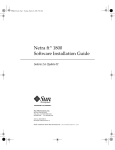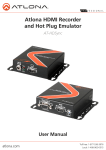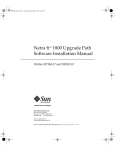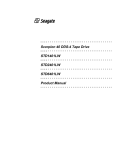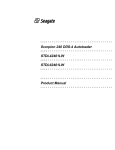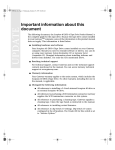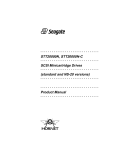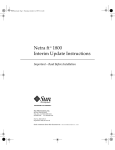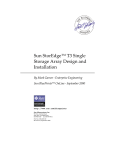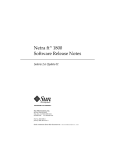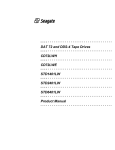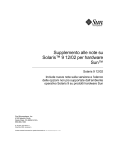Download Sun Microsystems 1800 Computer Accessories User Manual
Transcript
Netra™ ft 1800 Installation Guide Sun Microsystems, Inc. 901 San Antonio Road Palo Alto, CA 94303-4900 USA 650 960-1300 Fax 650 969-9131 Part No.: 805-4533-10 Revision A, February 1999 Send comments about this document to: [email protected] Copyright 1999 Sun Microsystems, Inc., 901 San Antonio Road • Palo Alto, CA 94303 USA. All rights reserved. This product or document is protected by copyright and distributed under licenses restricting its use, copying, distribution, and decompilation. No part of this product or document may be reproduced in any form by any means without prior written authorization of Sun and its licensors, if any. Third-party software, including font technology, is copyrighted and licensed from Sun suppliers. Parts of the product may be derived from Berkeley BSD systems, licensed from the University of California. UNIX is a registered trademark in the U.S. and other countries, exclusively licensed through X/Open Company, Ltd. Sun, Sun Microsystems, the Sun logo, AnswerBook, Java, the Java Coffee Cup, Netra and Solaris are trademarks, registered trademarks, or service marks of Sun Microsystems, Inc. in the U.S. and other countries. All SPARC trademarks are used under license and are trademarks or registered trademarks of SPARC International, Inc. in the U.S. and other countries. Products bearing SPARC trademarks are based upon an architecture developed by Sun Microsystems, Inc. Registered Excellence (and Design) is a certification mark of Bellcore. The OPEN LOOK and Sun™ Graphical User Interface was developed by Sun Microsystems, Inc. for its users and licensees. Sun acknowledges the pioneering efforts of Xerox in researching and developing the concept of visual or graphical user interfaces for the computer industry. Sun holds a non-exclusive license from Xerox to the Xerox Graphical User Interface, which license also covers Sun’s licensees who implement OPEN LOOK GUIs and otherwise comply with Sun’s written license agreements. RESTRICTED RIGHTS: Use, duplication, or disclosure by the U.S. Government is subject to restrictions of FAR 52.227-14(g)(2)(6/87) and FAR 52.227-19(6/87), or DFAR 252.227-7015(b)(6/95) and DFAR 227.7202-3(a). DOCUMENTATION IS PROVIDED “AS IS” AND ALL EXPRESS OR IMPLIED CONDITIONS, REPRESENTATIONS AND WARRANTIES, INCLUDING ANY IMPLIED WARRANTY OF MERCHANTABILITY, FITNESS FOR A PARTICULAR PURPOSE OR NONINFRINGEMENT, ARE DISCLAIMED, EXCEPT TO THE EXTENT THAT SUCH DISCLAIMERS ARE HELD TO BE LEGALLY INVALID. Copyright 1999 Sun Microsystems, Inc., 901 San Antonio Road • Palo Alto, CA 94303 Etats-Unis. Tous droits réservés. Ce produit ou document est protégé par un copyright et distribué avec des licences qui en restreignent l’utilisation, la copie, la distribution, et la décompilation. Aucune partie de ce produit ou document ne peut être reproduite sous aucune forme, par quelque moyen que ce soit, sans l’autorisation préalable et écrite de Sun et de ses bailleurs de licence, s’il y en a. Le logiciel détenu par des tiers, et qui comprend la technologie relative aux polices de caractères, est protégé par un copyright et licencié par des fournisseurs de Sun. Des parties de ce produit pourront être dérivées des systèmes Berkeley BSD licenciés par l’Université de Californie. UNIX est une marque déposée aux Etats-Unis et dans d’autres pays et licenciée exclusivement par X/Open Company, Ltd. Sun, Sun Microsystems, le logo Sun, AnswerBook, Java, le logo Jave Coffee Cup, Netra et Solaris sont des marques de fabrique ou des marques déposées, ou marques de service, de Sun Microsystems, Inc. aux Etats-Unis et dans d’autres pays. Toutes les marques SPARC sont utilisées sous licence et sont des marques de fabrique ou des marques déposées de SPARC International, Inc. aux Etats-Unis et dans d’autres pays. Les produits portant les marques SPARC sont basés sur une architecture développée par Sun Microsystems, Inc. L’interface d’utilisation graphique OPEN LOOK et Sun™ a été développée par Sun Microsystems, Inc. pour ses utilisateurs et licenciés. Sun reconnaît les efforts de pionniers de Xerox pour la recherche et le développement du concept des interfaces d’utilisation visuelle ou graphique pour l’industrie de l’informatique. Sun détient une licence non exclusive de Xerox sur l’interface d’utilisation graphique Xerox, cette licence couvrant également les licenciés de Sun qui mettent en place l’interface d’utilisation graphique OPEN LOOK et qui en outre se conforment aux licences écrites de Sun. CETTE PUBLICATION EST FOURNIE "EN L’ETAT" ET AUCUNE GARANTIE, EXPRESSE OU IMPLICITE, N’EST ACCORDEE, Y COMPRIS DES GARANTIES CONCERNANT LA VALEUR MARCHANDE, L’APTITUDE DE LA PUBLICATION A REPONDRE A UNE UTILISATION PARTICULIERE, OU LE FAIT QU’ELLE NE SOIT PAS CONTREFAISANTE DE PRODUIT DE TIERS. CE DENI DE GARANTIE NE S’APPLIQUERAIT PAS, DANS LA MESURE OU IL SERAIT TENU JURIDIQUEMENT NUL ET NON AVENU. Please Recycle Contents 1. Before Installation 1 Electrical Supply Considerations Environmental Considerations Dimensions 1 1 2 Airflow Consideration when Mounting in the Equipment Frame 2 Mechanical Considerations when Mounting in the Equipment Frame Mounting Requirements 2. Hardware Installation 6 9 Unshipping and Mounting the System Mounting Flanges 6 9 13 19-inch Mountings 13 23-inch, 24-inch and 600mm Mountings Cable Bracket Assemblies 22 Removing and Installing Modules 23 Module Injector/Ejector Mechanisms Replacing an RMM 23 30 Replacing a Disk Chassis Flexible Module Cabling 18 32 35 iii Installing the Filter Trays 36 CAF External I/O Connections 38 System Console Terminal Connections 3. Modem Port Connections 40 Alarms Port Connections 41 Electrical Supply Installation 43 System Switch 43 DC Source Site Requirements 44 Overcurrent Protection Requirements Required Connection Materials Dual Grounding Environment Connecting the Power Leads 44 48 DC Supply and Ground Conductor 48 49 51 4. Powering on the System 55 5. Software and Operating Environment Installation Netra ft 1800 Install Media Disk Space Requirement Installation Methods Local Installation Before You Start 57 57 58 58 Network Installation 59 60 Finishing Installation 63 Setting up Access to Netra ft 1800 CMS Utilities Setting the MANPATH Variable iv 39 Netra ft 1800 Installation Guide • February 1999 63 63 57 6. Installing and Configuring Sun StorEdge Volume Manager Before You Install Sun StorEdge Volume Manager Installing the Volume Manager Software Mounting the CD-ROM Manually Running the Installation 67 67 Initializing the Volume Manager Boot Disk Aliases Index 68 69 70 Setting up Other Disks Configuring Storage 65 67 Setting up the Volume Manager Environment Setting up Boot Disks 65 71 71 72 73 Contents v vi Netra ft 1800 Installation Guide • February 1999 Figures FIGURE 1-1 Netra ft 1800 Airflow Requirements (External) FIGURE 1-2 Netra ft 1800 Airflow Requirements (Internal) FIGURE 2-1 Shipping Brackets and Sacrificial Plinth FIGURE 2-2 Location Matrix For Mounting Flange Screws (19-inch rack) 14 FIGURE 2-3 Support Rail and Fixings (19-inch Rack) FIGURE 2-4 Orientation of Support Rail Spacers 16 FIGURE 2-5 Rear Rack Mounting (19-inch Rack) FIGURE 2-6 19-inch Rack Mounting Flange Kit 17 FIGURE 2-7 23-inch Rack Mounting Flange Kit 19 FIGURE 2-8 24-inch Rack Mounting Flange Kit 20 FIGURE 2-9 600-mm Rack Mounting Flange Kit FIGURE 2-10 Cable Bracket Assembly FIGURE 2-11 Module Injector/ejector Lever 24 FIGURE 2-12 Removing a CPUset Module 26 FIGURE 2-13 Removing a CAF FIGURE 2-14 Removing a PCI Card Carrier 28 FIGURE 2-15 Removing a Power Supply FIGURE 2-16 Removing an RMM Module FIGURE 2-17 Removing a Disk Drive 33 4 5 11 15 16 21 22 27 29 31 vii viii FIGURE 2-18 Removing a DSK Module 34 FIGURE 2-19 Cable Management Shelf FIGURE 2-20 Large Filter Tray 36 FIGURE 2-21 Small Filter Tray 37 FIGURE 2-22 External I/O Connections on CAF Module FIGURE 3-1 Circuit Breakers for Single Power Rails 46 FIGURE 3-2 Circuit Breakers for Dual Power Rails FIGURE 3-3 Location of Chassis-to-Logic-0V Link and Grounding Points, and Wrist Strap Connection Point 50 FIGURE 3-4 Power Inlet Filter FIGURE 3-5 Power Connector Wiring Polarity and Securing Screws FIGURE 3-6 Power Lead Receptacles 53 FIGURE 3-7 Power Lead Securing Screws 53 FIGURE 3-8 Power Cable Arrangement for Strain Relief FIGURE 4-1 System Switches (Front Panel) 56 35 38 47 51 Netra ft 1800 Installation Guide • February 1999 54 52 Tables TABLE 1-1 Mounting Hole Pattern Dimensions 7 TABLE 2-1 19-inch Mounting Flange Kit TABLE 2-2 Support Rail Screw Hole Locations 15 TABLE 2-3 23-inch, 24-inch and 600mm Mounting Flange Kits TABLE 2-4 Console Connector Pinout TABLE 2-5 Console and Modem Port Parameters TABLE 2-6 Modem Port Pinout TABLE 2-7 Alarms Port Pinout 41 TABLE 3-1 Overcurrent Protection Requirements TABLE 5-1 Suggested Disk Layout 13 18 39 39 40 44 62 ix x Netra ft 1800 Installation Guide • February 1999 Preface This document describes the installation procedures for the core hardware and software used in the Netra™ ft 1800. Upon completion of the procedures in this manual, the Netra ft 1800 is fully functional as a fault-tolerant Solaris™ server. Who Should Use This Book This guide is intended to be read by installation engineers, software support personnel and service personnel. It is not intended for the end user of the system. How This Book Is Organized This guide is arranged as follows: Chapter 1 “Before Installation” gives guidelines on site preparation and environmental considerations. Chapter 2 “Hardware Installation” describes how to unpack the system, fit the mounting flanges and install the chassis in a rack. Chapter 3 “Electrical Supply Installation” provides the information required to install the electrical supply. Chapter 4 “Powering on the System” tells you how apply power to the Netra ft 1800. Chapter 5 “Software and Operating Environment Installation” explains the software installation procedure. xi Chapter 6 “Installing and Configuring Sun StorEdge Volume Manager” summarizes what you need to know in order to use the Volume Manager on the Netra ft 1800. Related Books ■ ■ ■ ■ ■ ■ ■ ■ ■ ■ Netra ft 1800 Software Release Notes (Part No. 805-4527-10) Netra ft 1800 Hardware Release Notes (Part No. 806-0179-10) Netra ft 1800 CMS API Developer’s Guide (Part No. 805-5870-10) Netra ft 1800 CMS Developer’s Guide (Part No. 805-7899-10) Netra ft 1800 Developer’s Guide (Part No. 805-4530-10) Netra ft 1800 Hardware Reference Guide (Part No. 805-4531-10) Netra ft 1800 User’s Guide (Part No. 805-4529-10) Netra ft 1800 Reference Manual (Part No. 805-4532-10) Netra ft 1800 Safety and Compliance Manual (Part No. 805-7019-10) Sun StorEdge™ Volume Manager 2.5.4 Installation Guide (Part No. 805-5706-10). What Typographic Changes Mean The following table describes the typographic changes used in this book. TABLE P-1 Typographic conventions Typeface or Symbol xii Meaning Example AaBbCc123 The names of commands, files, and directories; on-screen computer output Edit your .login file. Use ls -a to list all files. machine_name% You have mail. AaBbCc123 What you type, contrasted with on-screen computer output machine_name% su Password: AaBbCc123 Command-line placeholder: replace with a real name or value To delete a file, type rm filename. AaBbCc123 Book titles, new words or terms, or words to be emphasized Read Chapter 6 in User’s Guide. These are called class options. You must be root to do this. Netra ft 1800 Installation Guide • February 1999 Shell Prompts in Command Examples The following table shows the default Open Boot PROM (OBP) prompt and the system prompt and superuser prompt for the C shell, Bourne shell, and Korn shell. TABLE P-2 Shell prompts Shell Prompt Open Boot PROM prompt ok C shell prompt machine_name% C shell superuser prompt machine_name# Bourne shell and Korn shell prompt $ Bourne shell and Korn shell superuser prompt # Symbols The following symbols mean: Note – A note provides information which should be considered by the reader. ! Caution – Cautions accompanied by this Attention icon carry information about procedures or events which if not considered may cause damage to the data or hardware of your system. Caution – Cautions accompanied by this Hazard icon carry information about procedures which must be followed to reduce the risk of electric shock and danger to personal health. Follow all instructions carefully. Preface xiii Sun Documentation on the Web The docs.sun.comsm web site enables you to access Sun technical documentation on the Web. You can browse the docs.sun.com archive or search for a specific book title or subject at: http://docs.sun.com Sun Welcomes Your Comments We are interested in improving our documentation and welcome your comments and suggestions. You can email your comments to us at: [email protected] Please include the part number of your document in the subject line of your email. xiv Netra ft 1800 Installation Guide • February 1999 CHAPTER 1 Before Installation This section provides information on what should be considered when choosing a location for a Netra ft 1800 system. Note – This equipment is only intended for installation in a Restricted Access Location as defined by UL1950, 3rd Edition, and EN60950: 1992 / A11: 1997. Electrical Supply Considerations Before you install the system, verify that the correct power supply is available. Refer to “DC Source Site Requirements” on page 44 for further information. Environmental Considerations The system can be installed in an environment with the following specific parameter ranges: ■ Ambient temperature ■ Operating: 0 to 40 degrees Celsius (short term operation up to a temperature of 50 degrees Celsius is possible; however, the operation of removable media devices cannot be guaranteed.) ■ Storage: –40 to 70 degrees Celsius 1 ■ Relative humidity ■ Operating: 5 to 85% noncondensing1 ■ Storage: 10 to 90% noncondensing1 ■ Elevation ■ Operating: 0 to 3000 meters ■ Storage: 0 to 12000 meters Dimensions ■ ■ ■ ■ ■ ■ Height: 1466.85 mm (57.75 inches) 33U NOM Width: 437.60 mm (17.22 inches) Depth: 392.8 mm (15.4 inches) Weight: Maximum 190.5 kg (420 lb) (excluding rack or AC converter items) Maximum rate of heat release for fully configured system: 3000W (10,200 Btu/hour) GR 63 CORE heat release calculation result: 425.4 W per square foot [3000 W / (3.25 ft x 2.17 ft)] (4579 W per square meter). These dimensions are for the product without rack-mount flange adapters; the overall width of the flanges varies according to the equipment mounting requirements. The depth given does not include any I/O or power connectors. The power connectors add 50 mm (2 inches) to the depth. Airflow Consideration when Mounting in the Equipment Frame The Netra ft 1800 system has been designed to function while mounted in a natural convection airflow, but to meet the declared environmental specification the following rules apply. Refer to FIGURE 1-1 on page 1-4 and FIGURE 1-2 on page 1-5. 1. Adequate airflow through the equipment frame must be ensured. The Netra ft 1800 system utilizes internal fans that can achieve a maximum airflow of 840 cfm in free air. 2. The inlet air must enter at the bottom of the Netra ft 1800 cabinet and in front of the Power Supply Units (PSUs); the airflow exhausts vertically from the top of the cabinet. 1. Subject to a maximum absolute humidity of 0.024Kg of water per Kg of dry air. 2 Netra ft 1800 Installation Guide • February 1999 3. A minimum of 2U (88.9 mm/3.5 inches) clearance must be allowed at both top and bottom of the Netra ft 1800 cabinet when mounted to allow adequate inlet and exhaust ventilation. 4. The Netra ft 1800 system must not be mounted above any heat-generating sources within the same frame unless a heat deflector is used to provide fresh inlet air at ambient temperature. 5. To maintain adequate airflow, replace the environmental filters every six months (contact your local support organization for further information). The environmental filter replacement kit (X-Option No.X6952A) contains six PSU filters and three base filters. Chapter 1 Before Installation 3 Minimum 2U (90 mm) gap Minimum 2U (90 mm) gap FIGURE 1-1 4 Netra ft 1800 Airflow Requirements (External) Netra ft 1800 Installation Guide • February 1999 Min. 2U (90 mm) gap at top of system CAF CAF PSU PSU CPU CPU PSU CPU PSU PSU PSU CAF CAF Front Rear Front Front Rear Min. 2U (90 mm) gap at base of system Fan unit Min. 75 mm between front of system and rack door (if fitted) FIGURE 1-2 Netra ft 1800 Airflow Requirements (Internal) Chapter 1 Before Installation 5 Mechanical Considerations when Mounting in the Equipment Frame Caution – Mechanical assistance is required if installing a loaded chassis. If you intend not to use a lifting device for installation, all modules other than the motherboards must be removed from the system prior to lifting. The empty chassis weighs approximately 49 kg (108 lb), or 68 kg (150 lb) with the motherboards, plus the adaptors. The weight of any removable module depends on its configuration. Weight warning labels are for guidance only. See “Removing and Installing Modules” on page 23 for information about adding modules to the motherboard. The Netra ft 1800 chassis has been designed to accommodate most mounting configurations. Adaptor flanges to suit 19-inch, 23-inch, 24-inch and 600-mm (ETSI) rack sizes are available as required. The Netra ft 1800 system is shipped with a plinth, which protects the bottom of the chassis during transit and handling, and also ensures that the correct airflow inlet plenum is provided during installation. The plinth must be removed once the Netra ft 1800 is installed in a rack, then stored in a safe place. The Netra ft 1800 chassis must be mounted using screws suitable for the equipment frame. The screws should be M5, M6 or 10-32 UNF. All screws must be fitted. The recommended tightening torque value for either M5 or 10-32 UNF recess head screws is 3.8 Nm (2.8 lbf/ft), and that for M6 screws is 6 Nm (4.4 lbf/ft). Mounting Requirements The Netra ft 1800 is available with the following removable mounting flanges: ■ ■ ■ ■ 19 inch EIA pattern 23 inch EIA pattern 24 inch EIA pattern 600 mm IEC917 (ETSI) pattern Any of these flanges can be fitted in the following positions: ■ ■ ■ Flush with the front of the system 65 mm (2.56 inches) from front of system 196.1 mm (7.72 inches) from front of system The second and third positions are intended for use with 5-inch web open frames (relay racks). 6 Netra ft 1800 Installation Guide • February 1999 Adjustable rear flanges can be fitted. They provide a mounting face anywhere between 400 mm and 500 mm (15.75 inches and 19.7 inches) from the front of the system (see “Mounting Flanges” on page 13). The vertical mounting hole pattern should conform to the standard dimensions given in TABLE 1-1. TABLE 1-1 Mounting Hole Pattern Dimensions Standard Pattern EIA/RETMA (RU) Repeating pattern of 5/8 inch, 5/8 inch, 1/2 inch IEC917/ETSI (SU) Constant pitch of 25 mm Loading The rack must be capable of supporting 230 kg (500 lbs) for a fully configured and cabled Netra ft 1800. In Seismic (Earthquake) Risk Zones 3 and 4, it is recommended that the Netra ft 1800 is installed in an appropriate secured seismic rack or cabinet. Vertical space The Netra ft 1800 chassis occupies 33RU (57.75 inches) of vertical height. To allow adequate airflow, the rack must provide a minimum of 38RU (66 inches) of rackable height, together with minimum inlet and exhaust vents of 2U gap each. If the rack provides unobstructed vertical airflow via vents of adequate size in the top and/or bottom panels, then the minimum rack vertical opening required is 37RU (64.75 inches). When you fit the Netra ft 1800 into a rack with its red transit plinth in place, allow 1U (1.75 inches) of clearance beneath the plinth. This space permits removal of the plinth. Note – The plinth must be removed to allow fitment of the chassis environmental filters. Chapter 1 Before Installation 7 Depth The front door (if fitted) must provide a minimum of 75 mm (3 inches) of clearance across the entire front surface of the Netra ft 1800 to allow for routing of I/O cables. As all I/O cables must be routed from the front of the Netra ft 1800 system, due consideration should be made of the space required within the rack for these cables, as well as the power cables at the rear of the system. There must be a minimum of 545 mm (21.5 inches) usable internal depth in the rack/ cabinet. This dimension includes space for connector housings, cabling and the power inlet filters. Safety All racks must be bolted to the floor, to adjacent frames or to both. This must be done in accordance with the rack manufacturer’s instructions, using the recommended hardware and fixings. Free-standing racks with a footprint of less than 600 mm x 600 mm (23.6 inches x 23.6 inches) are likely to be unstable and should be treated with caution. 8 Netra ft 1800 Installation Guide • February 1999 CHAPTER 2 Hardware Installation This chapter provides information on the initial hardware installation procedure, including installing modules and external I/O connections. Unshipping and Mounting the System Once you have removed the packaging from the system, you must then unship the system from the delivery pallet and brackets before attempting to mount the chassis in a rack. Caution – Do not attempt to remove the red plinth before the chassis has been mounted in the rack. There is an instruction card attached to the front of the system; the instructions below are intended to supplement this. Note – Do not discard the packaging after removing it from the system. It should be stored in safe, dry place so it can be used in the event that the system requires moving or returning for repair. Tools The tools required to unship the system are contained in a cloth bag attached to the chassis. 9 Note – Do not discard the tools after unshipping and mounting the system. They can be stored in the cloth bag supplied and attached to the rack adjacent to the system for easy access when required. 10 Netra ft 1800 Installation Guide • February 1999 ▼ To Unship and Mount the System 3 x Phillips screws at rear of plinth 4 x Phillips screws at front of plinth 2 x Allen bolts securing bracket to pallet Insert lifting device here 2 x Phillips screws on each bracket FIGURE 2-1 Shipping Brackets and Sacrificial Plinth Chapter 2 Hardware Installation 11 1. Remove all modules except the motherboards from the chassis and put them in a safe place. Refer to “Removing and Installing Modules” on page 23. 2. Using the Phillips No.2 screwdriver (supplied), remove the two Phillips screws securing the four red brackets (two on each side) to the chassis (see FIGURE 2-1). You may also need to remove the brackets from the pallet. Use the Allen key supplied to remove the two Allen screws from each bracket. The brackets are not attached to the red mounting plinth. 3. Install the appropriate mounting flanges. Refer to “Mounting Flanges” on page 13. 4. Use an appropriate lifting device to lift the chassis by the red mounting plinth, and install it in the rack. Caution – If using a fork-lift device, ensure the tines of the lift extend right through the mounting plinth and beyond the rear of the chassis. The chassis could deform if you use incorrect lifting techniques. 5. Secure the chassis into the rack using the appropriate mounting points. See “Mounting Flanges” on page 13. 6. Remove the mounting plinth. Use the No.2 Phillips screwdriver supplied to remove the four screws from the front and the three screws from the rear. Mounting the chassis with the plinth attached ensures that the minimum amount of clearance for air flow is provided beneath the system. 7. Install the two large and one small filter trays in the spaces immediately beneath the chassis revealed by the removal of the plinth. Refer to “To Install the Filter Trays” on page 36. The filter tray thumbscrews are inserted in the tapped threads exposed by removal of the mounting plinth. 8. Install the modules into their appropriate locations. Refer to “Removing and Installing Modules” on page 23. 12 Netra ft 1800 Installation Guide • February 1999 Mounting Flanges The system is supplied with the appropriate mounting flanges; other mounting flanges kits are available, as follows, to enable the system to mounted in different industry-standard racks: ■ ■ ■ ■ 19-inch racks X-Option No.X6938A 23-inch racks X-Option No.X6939A 24-inch racks X-Option No.X6940A ETSI (600 mm) racks X-Option No.X6941A Each mounting kit also includes six cable bracket assemblies, which can be fitted to the mounting flanges to facilitate cable management; see “Cable Bracket Assemblies” on page 22. 19-inch Mountings The 19-inch mounting kit consists of the following items: TABLE 2-1 19-inch Mounting Flange Kit Quantity Item Part number 1 Front left-hand mounting flange 340-4699 1 Front right-hand mounting flange 340-4698 1 Rear top left mounting flange 340-5479 1 Rear top right mounting flange 340-5480 1 Rear bottom left mounting flange 340-5481 1 Rear bottom right mounting flange 340-5482 16 Spacers 340-5483 8 Support rails 340-5484 6 Cable hook bracket with hooks already installed 340-5553 16 M4 10mm panhead screws (for rear flanges) N/A 16 M4 crinkle washers (for M4 screws) N/A 20 M5 8mm countersunk screws (for front flanges) N/A 16 M5 10mm countersunk screws (for support rails) N/A Refer to FIGURES 2-3 to 2-6. Chapter 2 Hardware Installation 13 The sides of the system chassis are provided with tapped screwholes as shown in FIGURE 2-2. Front of system Rear of system Columns D C B A 1 2 3 4 5 Row numbers Support rails (340-5484) 6 7 8 9 10 FIGURE 2-2 Location Matrix For Mounting Flange Screws (19-inch rack) The front flanges (see FIGURE 2-6 on page 17) are screwed to holes in column C or column D. Use column B only if the rear flanges are not going to be used. The support rails (see FIGURE 2-7 on page 19) are screwed to holes A and B in rows 1, 4, 7 and 10. The spacers provided must be used between the rails and the chassis to prevent the rails being fouled by the rivets in the chassis metalwork. 14 Netra ft 1800 Installation Guide • February 1999 Spacer Spacer (340-5483) G G F1 F2 FIGURE 2-3 F3 F4 E1 E2 F5 E3 E4 E5 Support Rail and Fixings (19-inch Rack) The mounting screws should be placed in position pairs E1 and F1, E2 and F2, E3 and F3, E4 and F4 or E5 and F5. The pair of holes to be used depends on the frontto-back depth of the rack (mounting flange to mounting flange). The holes marked with the appropriate figure, as shown in TABLE 2-2, should be closest to the rear of the chassis. TABLE 2-2 Support Rail Screw Hole Locations Rack depth Screw holes 480 mm E5 and F5 530 mm E4 and F4 580 mm E3 and F3 630 mm E2 and F2 680 mm E1 and F1 The slots labeled G are used for mounting the rear flanges (see FIGURE 2-6 on page 17). Only one of the vertical pairs of holes in the rear flanges should be used. The spacers must be placed with the flat side towards the chassis and the countersink towards the support rail (see FIGURE 2-4). Chapter 2 Hardware Installation 15 Support rail (340-5484) Chassis Screw Spacer (340-5483) FIGURE 2-4 Orientation of Support Rail Spacers The rear flanges are used to mount the chassis in the rear of the rack as shown in FIGURE 2-5. M5 10mm countersunk screw Chassis Support rail (340-5484) Spacer (340-5483) M5 10mm countersunk screw M4 10mm panhead screw and crinkle washer Rack Rear flange (340-5479/5480) Lockable fixing (not supplied) Rack rear mounting flange FIGURE 2-5 16 Rear Rack Mounting (19-inch Rack) Netra ft 1800 Installation Guide • February 1999 Support rail (340-5484) Spacer Use M5 10mm (340-5483) screws Rear top mounting flange (left 340-5479 right 340-5480) Use M4 10mm screws Front mounting flange (left 340-4699 right 340-4698) Use M5 8mm screws Rear bottom mounting flange (left 340-5481 right 340-5482) Use M4 10mm screws FIGURE 2-6 19-inch Rack Mounting Flange Kit Chapter 2 Hardware Installation 17 23-inch, 24-inch and 600mm Mountings The 23-inch, 24-inch and 600mm mounting kits consist of the following items: TABLE 2-3 23-inch, 24-inch and 600mm Mounting Flange Kits Part number Quantity Item 23-inch 24-inch 600mm 1 Front left-hand mounting flange 340-4592 340-5445 340-5328 1 Front right-hand mounting flange 340-4591 340-5446 340-5329 2 Rear top mounting flange 340-5449 340-5447 340-5331 2 Rear bottom mounting flange 340-5450 340-5448 340-5427 8 Support rails 340-5330 340-5330 340-5330 6 Cable hook bracket with hooks already installed 340-5553 340-5553 340-5553 40 M5 6mm panhead screws (for front and rear flanges) N/A N/A N/A 16 M5 8mm countersunk screws (for support rails) N/A N/A N/A Refer to FIGURE 2-7 on page 19 for 23-inch kits, FIGURE 2-8 on page 20 for 24-inch kits and FIGURE 2-9 on page 21 for 600mm kits. The sides of the system chassis are provided with tapped screwholes as shown in FIGURE 2-2 on page 14. Fit the front brackets using the screwholes in columns C and D, or just column C, or just column D. Screw the slide mounts to holes A and B in rows 1, 4, 7 and 10. You can then screw the rear brackets to the rear of the rack (see FIGURE 2-7, FIGURE 2-8 and FIGURE 2-9) and slide the chassis onto the brackets until the front brackets are flush with the front of the rack. 18 Netra ft 1800 Installation Guide • February 1999 Rear top mounting flange (340-5449) Use M5 6mm screws Front mounting flange (left 340-4592 right 340-4591) Use M5 6mm screws Slide support (340-5330) Use M5 8mm screws Rear bottom mounting flange (340-5450) Use M5 6mm screws FIGURE 2-7 23-inch Rack Mounting Flange Kit Chapter 2 Hardware Installation 19 Rear top mounting flange (340-5447) Use M5 6mm screws Front mounting flange (left 340-5445 right 340-5446) Use M5 6mm screws Slide support (340-5330) Use M5 8mm screws Rear bottom mounting flange (340-5448) Use M5 6mm screws FIGURE 2-8 20 24-inch Rack Mounting Flange Kit Netra ft 1800 Installation Guide • February 1999 Rear top mounting flange (340-5331) Use M5 6mm screws Front mounting flange (left 340-5328 right 340-5329) Use M5 6mm screws Slide support (340-5330) Use M5 8mm screws Rear bottom mounting flange (340-5427) Use M5 6mm screws FIGURE 2-9 600-mm Rack Mounting Flange Kit Chapter 2 Hardware Installation 21 Cable Bracket Assemblies Six cable bracket mounting assemblies are provided with each mounting flange kit. These can be fitted to the mounting flanges to facilitate cable management. FIGURE 2-10 Cable Bracket Assembly The brackets can be fixed to the mounting flanges in the required position, using the same screws that fix the flanges to the rack. The hooks can be fitted to the brackets in one of three positions using the countersunk M3 screws supplied. The hooks must be fitted before the brackets are fixed to the mounting flange/rack. 22 Netra ft 1800 Installation Guide • February 1999 Removing and Installing Modules This chapter describes how to remove and insert: ■ CPUset, PCI, CAF and PSU modules (“To Remove a Module” on page 24) ■ CPUset modules: “CPUset Modules” on page 25 ■ PCI modules: “PCI Modules” on page 28 ■ CAF modules: “CAF Modules” on page 27 ■ PSU modules: “PSU Modules” on page 29 ■ Drive chassis (“Replacing a Disk Chassis” on page 32) ■ Removable media module (“Replacing an RMM” on page 30) Caution – The wrist-strap provided must be used when replacing modules, or making cable connections to the rear of the system. The wrist-strap connection point on the Netra ft 1800 system is located on the panel at the bottom rear of the chassis. All modules have their own guides in slots in the chassis, into which they fit exactly. No module will fit into a slot allocated to a different class of module. No module will fit into its own slot if it is upside down. Module Injector/Ejector Mechanisms All the modules except the disk chassis (DSK) and RMM have an injector/ejector lever (CPUset modules have two). They are all similar in function and usage. A common feature is a slide which engages and disengages the module’s electrical connection to the motherboard, and a lever which physically engages and disengages the module. When the latch is disengaged, a red dot is exposed. This facilitates the identification of unlatched injectors. Chapter 2 Hardware Installation 23 Open Closed FIGURE 2-11 Red warning dot Module Injector/ejector Lever The module is disengaged from its electrical connection when the slide is moved towards the rounded end of the lever, exposing the red warning dot. The general procedure refers to CPUset, CAF, PCI and PSU modules. For more specific instructions for the RMM and disk chassis, refer to: ■ ■ ▼ “Replacing an RMM” on page 30 “Replacing a Disk Chassis” on page 32 To Remove a Module 1. Move the slide in the lever on the module to the disengaged position. This will expose the red warning dot. 2. Lower the lever. The module will slide out a small amount when the lever is fully lowered. 3. Slide the module out of its slot, using the handle if there is one. For specific procedures relating to individual modules, refer to: 24 ■ “CPUset Modules” on page 25 ■ “CAF Modules” on page 27 ■ “PCI Modules” on page 28 ■ “PSU Modules” on page 29 Netra ft 1800 Installation Guide • February 1999 CPUset Modules CPUset modules have two injector levers which must be operated simultaneously. As you pull out the CPUset module, the handle in the top panel pops up and must be depressed again manually in order to withdraw the module fully from the chassis (see FIGURE 2-12). Once the handle is clear of the crossbar and has popped up again, it can be used to take the weight of the module. Caution – CPUset modules are very heavy. The weight warning label on the CPUset is for guidance only. The actual weight of a CPUset depends on its configuration. Both the front and top handles must be used simultaneously once the module has been withdrawn as illustrated in FIGURE 2-12. On inserting the CPUset module the handle must be depressed in order to push the module fully into the chassis. Chapter 2 Hardware Installation 25 FIGURE 2-12 26 Removing a CPUset Module Netra ft 1800 Installation Guide • February 1999 CAF Modules FIGURE 2-13 Removing a CAF Chapter 2 Hardware Installation 27 PCI Modules FIGURE 2-14 28 Removing a PCI Card Carrier Netra ft 1800 Installation Guide • February 1999 PSU Modules FIGURE 2-15 Removing a Power Supply Chapter 2 Hardware Installation 29 ▼ To Replace a Module 1. Slide the module into its slot but not fully home. A module will not fit into a slot designed for a different class of module. 2. When the lever engages with the chassis, raise it to push the module fully home. 3. Move the slide in the lever into the engaged position. Replacing an RMM RMM modules have a slide with an actuator microswitch on an ejector handle. The slide controls the electrical connection to the motherboard. When the slide is closed (to the right), the electrical connection is engaged; when it is open (to the left), the electrical connection is disengaged. The handle is lifted to disengage the module physically, and lowered to engage it. ▼ To Remove the RMM 1. Slide the latch in the handle of the RMM to the left (towards the ‘unlocked’ symbol). 2. Lift the handle. 3. Slide the RMM out of its slot. 30 Netra ft 1800 Installation Guide • February 1999 FIGURE 2-16 Removing an RMM Module Chapter 2 Hardware Installation 31 ▼ To Replace the RMM 1. Slide the RMM into its slot until it is almost completely home. A module will not fit into a slot designed for a different class of module. 2. Lower the handle to engage the RMM fully in its slot. 3. Slide the latch in the handle to the right (towards the ‘locked’ symbol). Replacing a Disk Chassis DSK modules have a slide on an ejector handle. The handle is lifted to disengage the module physically, and lowered to engage it. ▼ To Remove the Disk Chassis 1. Remove any HDD modules (hard disks) in the disk chassis. Refer to FIGURE 2-17 on page 33. Caution – Always remove all hard disk drive modules before removing a disk chassis. Always put a hard disk back in the same location from which you removed it. 2. Slide the latch in the handle of the disk chassis to the left (towards the ‘unlocked’ symbol). 3. Lift the handle. 4. Slide the disk chassis out of its slot. 32 Netra ft 1800 Installation Guide • February 1999 NOTE: The injector/ejector lever of a disk drive module does not switch the power on and off. If the chassis is powered on, the disk drive will power off when it is removed and power on as soon as it is inserted, regardless of the position of the lever. FIGURE 2-17 Removing a Disk Drive Chapter 2 Hardware Installation 33 FIGURE 2-18 Removing a DSK Module ▼ To Replace the Disk Chassis 1. Slide the disk chassis into its slot until it is almost completely in. 2. Lower the handle to engage the disk chassis fully in its slot. 3. Slide the latch in the handle to the right (towards the ‘locked’ symbol). 4. Replace the hard disk drives. 34 Netra ft 1800 Installation Guide • February 1999 Flexible Module Cabling The cable management shelf is illustrated in FIGURE 2-19. FIGURE 2-19 Cable Management Shelf The cable management shelf adjacent to the PCI card locations is flexible and can be used in a number of different configurations. The holes are equidistant, and the hooks can be inserted in whatever position is required. The hooks are a firm push-fit into the holes. Chapter 2 Hardware Installation 35 Installing the Filter Trays The Netra ft 1800 has three filter trays, two large and one small. ▼ To Install the Filter Trays FIGURE 2-20 36 Large Filter Tray Netra ft 1800 Installation Guide • February 1999 FIGURE 2-21 Small Filter Tray 1. Insert the trays into the appropriate apertures at the base of the chassis; the two large trays are fitted on the left and the small tray on the right. It is unimportant which way up the trays are fitted. 2. Push the trays securely home and hand-tighten the two thumbscrews on each. The thumbscrews are inserted into the tapped threads exposed by removal of the sacrificial mounting plinth. Chapter 2 Hardware Installation 37 CAF External I/O Connections The Netra ft 1800 system has the following connectors on each CAF module: ■ ■ ■ ■ Modem port (DB-25) Female 25-pole D-type connectors for the system console and modem ports (RS232). A male 9-pole D-type connector for the Remote Control Processor (RCP) ports. A male 15-pole D-type connector for the alarm relay/reset signals. Two RJ45 Ethernet ports. Ethernet ports (RJ45) CAF Console port (DB-25) FIGURE 2-22 38 Remote Control Processor port (DB-9) Alarm port (DB-15) External I/O Connections on CAF Module Netra ft 1800 Installation Guide • February 1999 System Console Terminal Connections The system console and modem connections are provided on separate 25-pole female D-type connectors. TABLE 2-4 shows the pin allocation on these connectors. TABLE 2-4 Console Connector Pinout Pin Function Description 1 GND Chassis ground 2 TxD Output data 3 RxD Input data 7 SREF Signal reference Shield Chassis ground Except for pin 1, all pins of the console and modem connectors are isolated from the frame ground of the Netra ft 1800 system. The connectors have two screw-threaded mounting pillars with 4-40 UNC threads. You should secure the cable headshell in place with the screws engaged in these pillars. If you use a cable headshell without securing the screws, make sure that the pillars do not prevent full engagement of the connector. This can happen with some types of cable headshell where screw heads can foul against the mounting pillars. You must also secure the other end of the cable to the console terminal if the terminal provides some means of locking. Note – To ensure EMC compliance always use a high quality screened cable that has metal connector shells. TABLE 2-5 shows the console terminal configuration parameters for both console and modem ports. You can modify these parameters using Solaris utilities. TABLE 2-5 Console and Modem Port Parameters Parameter Setting Transmit rate 9600 baud Receive rate 9600 baud Data bits 8 Chapter 2 Hardware Installation 39 TABLE 2-5 Console and Modem Port Parameters (Continued) Parameter Setting Stop bits 1 Parity enable/sense off/off XON/XOFF protocol on System consoles can be connected only to the CAF module. Modem Port Connections The modem port pinout is described in TABLE 2-6. TABLE 2-6 Modem Port Pinout Pin Function Description 1 GND Chassis ground 2 TxD Output data 3 RxD Input data 4 RTS Output handshake 5 CTS Input handshake 7 SREF Signal reference 8 DCD Input status 20 DTR Output status Shield 40 Netra ft 1800 Installation Guide • February 1999 Chassis ground Alarms Port Connections The alarms port pinout is described in TABLE 2-7. TABLE 2-7 Alarms Port Pinout Pin Description Pin Description 1 RESET0+ 9 ALARM0-NC 2 RESET0- 10 ALARM0-COM 3 RESET1+ 11 ALARM1-NO 4 RESET1- 12 ALARM1-NC 5 SYSTEM-NO 13 ALARM1-COM 6 SYSTEM-NC 14 ALARM2-NO 7 SYSTEM-COM 15 ALARM2-COM 8 ALARM0-NO Chapter 2 Hardware Installation 41 42 Netra ft 1800 Installation Guide • February 1999 CHAPTER 3 Electrical Supply Installation This chapter provides information about the Netra ft 1800 system switches and the installation of the electrical supply. See the Netra ft 1800 Hardware Reference Manual for full details of the electrical supply hardware. The Netra ft 1800 has six power input feed pairs, three for each side, which plug in to the back of the system. These must be assembled by the user, as described in “Connecting the Power Leads” on page 51. Note – This equipment is only intended for installation in a Restricted Access Location as defined by UL1950, 3rd Edition, and EN60950: 1992 / A11: 1997. Note – In NORWAY, this requirement does not apply to permanently connected equipment or pluggable equipment type B, installed in areas where equipotential bonding has been applied, e.g. a telecommunications Central Office. System Switch The Netra ft 1800 in fault tolerant mode consists of two sides: processors and associated modules which function and are powered as separate systems. The system switches of the Netra ft 1800 function as standby devices for their respective sides, enabling and disabling the power supply units (PSU) outputs. The system switches are push, momentary switches. They are located on the CAF module on each side of the system. The system does not contain any integral circuit breakers. The only means of isolating the system from power is by means of external circuit breakers, to be provided by the user. 43 Note – The system On and Stby switches handle low voltage signals only; the highpower circuits do not pass through these switches. DC Source Site Requirements The DC source site requirements are as follows: ■ ■ ■ ■ Suitable for use in –48 Vdc ((classified SELV) nominal or –60 Vdc (classified TNV-2) nominal systems. The supply source must be electrically isolated by double or reinforced insulation from any hazardous AC or DC source. The DC source must be reliably connected to earth (that is, battery room positive bus is connected to the grounding electrode). The DC source must be capable of providing up to 925W of continuous power per feed pair. The sum of all three feeds on one side will be less than 1500W for single-feed and 3000W for dual feed. Overcurrent Protection Requirements Overcurrent protection devices must be provided as part of each host equipment rack. Circuit breakers meeting the requirements shown in TABLE 3-1 must be fitted between the DC source and the Netra ft 1800. TABLE 3-1 44 Overcurrent Protection Requirements Current rating 30A maximum Voltage Maximum 60 Vdc rated in –48 Vdc power systems Maximum 75 Vdc rated in –60 Vdc power systems Type Fast trip Protection Double pole breaking (both grounded and ungrounded conductor open on fault) Contact gap Minimum 3 mm Nuisance tripping Circuit breaker must not operate when presented with an inrush current of 27 amps and a duration of 2.5 microseconds Quantity One per feed, up to 12 per system Netra ft 1800 Installation Guide • February 1999 Caution – Double pole circuit breakers are required on each rail for DC installations. This is necessary because the return path of the current is not isolated in the PSU. FIGURE 3-1 on page 3-46 shows the required arrangement for single power rails. FIGURE 3-2 on page 3-47 shows the required arrangement for dual power rails. Note – Overcurrent devices must meet applicable national and local electrical safety codes and be approved for the intended application. Chapter 3 Electrical Supply Installation 45 Return A CB CB –48V supply A CB CB CB CB Return B RTN B RTN A –48V A –48V B –48V supply B RTN B RTN BA –48V A –48V B RTN B RTN A –48V A –48V B CB RTN B RTN A –48V A –48V B CB CB RTN B RTN A –48V A –48V B CB CB RTN B RTN A –48V A –48V B FIGURE 3-1 46 Circuit Breakers for Single Power Rails Netra ft 1800 Installation Guide • February 1999 CB Return A CB CB –48V supply A CB CB CB CB CB RTN B RTN A –48V A –48V B CB Return B –48V supply B CB RTN B RTN A –48V A –48V B CB CB RTN B RTN A –48V A –48V B CB CB CB CB CB CB CB CB FIGURE 3-2 RTN B RTN A –48V A –48V B CB CB RTN B RTN A –48V A –48V B CB CB RTN B RTN A –48V A –48V B CB Circuit Breakers for Dual Power Rails Chapter 3 Electrical Supply Installation 47 Required Connection Materials DC branch circuits: ■ The required number of field wiring kits are supplied in the shipkit with each system, according to configuration. Grounding: ■ ■ ■ One Thomas & Betts two-hole lug (part number: 54204-UB) suitable for 8 AWG conductor or UL/CSA approved equivalent having 5/8-inch pitch; torque value: 3.5 Nm maximum. A Thomas & Betts crimping tool (part number: TBM 5-S), or approved equivalent to secure the lug on to the cable. A grounding bus bar that is near the equipment and easily accessible. Dual Grounding Environment: ■ ! Additional Thomas & Betts two-hole lug for logic 0V studs. Caution – External filtering and/or surge suppression devices may be required on the power feeds where branch circuit electromagnetic characteristics are unknown. DC Supply and Ground Conductor The requirements are: ■ ■ ■ ■ ■ ■ ■ 48 Suitable conductor material: copper only. Supply conductors: 8 AWG (6 mm2) (between the Netra ft 1800 and the circuit breaker). Ground conductor: 8 AWG. Cable insulation rating: minimum 75 degrees Celsius, Low Smoke Fume (LSF), Flame Retardant. Cable type must be one of: ■ UL style 1028 or other UL 1581 compliant equivalent. ■ IEEE 383 compliant. ■ IEEE 1202-1991 compliant or classified. Branch circuit cable insulation color: per applicable national electrical codes. Grounding cable insulation color: green/yellow. Netra ft 1800 Installation Guide • February 1999 Dual Grounding Environment Caution – To be compatible with grounding environments requiring isolation between logic 0V and chassis ground, the fitted grounding bridge plate must be removed and individual connections made to logic 0V and chassis ground studs. The grounding bridge plate is located on the middle rear left edge of the unit between the motherboards. The grounding studs at the base of the chassis are M5 studs with appropriate nuts already installed. Before installation for dual grounding systems, remove the link from the chassis to logic 0V. This exposes a 2-hole lug with tapped M5 threads (refer to FIGURE 3-3). Caution – The use of certain PCI cards causes the frame and logic grounds to be commoned. Refer to the documentation supplied with the PCI card. ▼ To Connect the Ground Lead 1. Strip 9mm of insulation from each end of the grounding lead. 2. Insert the lead into the Thomas & Betts two-hole lug provided (part no. 52024-UB). Ensure that both the conductor and its insulation are gripped by the lug. 3. Position the lug and grounding lead assembly over the grounding studs. Refer to FIGURE 3-3 on page 3-50. Tighten the two M5 nuts over the locking washers provided. 4. Make the connection to the earthing bar at the end of the grounding lead. Ensure there is adequate strain relief for the cable. Chapter 3 Electrical Supply Installation 49 Chassis to logic 0V link Wrist strap connection point Grounding studs FIGURE 3-3 50 Location of Chassis-to-Logic-0V Link and Grounding Points, and Wrist Strap Connection Point Netra ft 1800 Installation Guide • February 1999 Connecting the Power Leads The inlet power filter must be plugged into the power sockets on the motherboards at the back of the Netra ft 1800, then the six power leads must be attached to the input power filter. Note – Disengage all the PSUs before you insert the power connectors. Inserting the connectors with the PSUs engaged can damage the connectors. Top of chassis Power lead securing screws Power lead receptacles Captive spring-loaded securing screw (2 off) Power inlet sockets Cable management loops FIGURE 3-4 Power Inlet Filter Chapter 3 Electrical Supply Installation 51 ▼ To Assemble the Power Inlet and Leads 1. Insert the socket in the appropriate slot on the motherboard. The socket can only be inserted one way round. The label on the front of the filter indicates the correct orientation. 2. Tighten the captive spring-loaded screws, preferably finger-tight only. If you use a screwdriver, these screws should be tightened no more than 6 in-lbf (0.68 Nm). Refer to FIGURE 3-5. + RETURN B + RETURN A Inlet filter securing screws – Negative A – Negative B FIGURE 3-5 Power Connector Wiring Polarity and Securing Screws 3. Strip 9mm of insulation from boths ends of each power lead. The connectors will not accommodate leads of greater than 8 AWG (6 mm2). 52 Netra ft 1800 Installation Guide • February 1999 4. Insert the leads into the appropriate receptacles in the terminal block. Refer to FIGURE 3-6. Insert power leads here FIGURE 3-6 Power Lead Receptacles 5. Tighten the terminal block power lead M4 securing screws to 1.5-1.8 Nm. Refer to FIGURE 3-7. Power lead securing screws FIGURE 3-7 Power Lead Securing Screws Chapter 3 Electrical Supply Installation 53 6. Use cable ties to secure the wires to the swivel loops in the mounting bracket (see FIGURE 3-8). The loops can be rotated to a convenient position. This strain relief method must be implemented. Caution – Observe correct working practices regarding the termination of cable ties. Cable tie FIGURE 3-8 Power Cable Arrangement for Strain Relief 7. Ensure the circuit breakers are open, then connect the other ends of the leads to the circuit breakers. Secure the cables using adequate strain relief. 54 Netra ft 1800 Installation Guide • February 1999 CHAPTER 4 Powering on the System This chapter describes the procedure for powering on the Netra ft 1800. ▼ To Power On the System 1. Prior to powering on, inspect the supply conductors for mechanical security. 2. Activate the external circuit breakers. Note – The power supply units (PSUs) remember their last requested state. They are shipped in the ON state. Because the external circuit breaker is activated when the last state of the PSU was ON, the PSU will power up at this point. 3. Push the On system switch on either CAF. 55 4. Push the other On system switch (on the other CAF front panel). On switch Standby switch CAF FIGURE 4-1 System Switches (Front Panel) The PSU, CPUset and CAF Power LEDs will successively light, and the terminal will display the output from the Power On Self Test (POST). The POST sequence may take some time. The CPUset LEDs will perform their own test sequence towards the end of the POST procedure, then the Target LED on one of the CPUsets will flash as the OBP ok prompt appears. 56 Netra ft 1800 Installation Guide • February 1999 CHAPTER 5 Software and Operating Environment Installation This chapter describes all the steps necessary to install a software and operating environment release for the Netra ft 1800. To perform the steps described here, you should be familiar with the Solaris operating environment. Netra ft 1800 Install Media The release software consists of the following: ■ ■ ■ Netra ft 1800 Full Installation containing Solaris and Netra ft 1800 install software. Sun StorEdge Volume Manager 2.5 media kit and Sun StorEdge Volume Manager patches. Supplemental CD, which contains PCI card drivers, SunVTS and other utilities. Disk Space Requirement Netra ft 1800 release software occupies approximately 540 Mbytes of disk space. 57 Installation Methods The Netra ft 1800 supports two types of installation: local, from a local CD-ROM drive; or network, from a machine set up as a Solaris installation server. The requirements for these two types of installation are described in the following subsections. You must install the Sun StorEdge Volume Manager package when the Netra ft 1800 installation is complete in order to implement fault tolerant operation. See Chapter 6 “Installing and Configuring Sun StorEdge Volume Manager” for more details. You should install patches after the Netra ft 1800 software installation. Recommended Solaris patches are included on the Netra ft 1800 Installation CDROM. Any recommended patches should be installed immediately after the reboot at the end of the installation. The local and network installation procedures differ only in their initial steps. Otherwise, the procedure is the same for both types of installation. Note – Inadvertent keyboard use during installation can abort installation. Local Installation To perform a local installation of the Netra ft 1800 software, you must have an RMM module that contains a CD-ROM drive in slot A-RMM or B-RMM of the Netra ft 1800 to be installed. Local installation involves booting the Netra ft 1800 from one of its CD-ROM drives while an installation CD-ROM is in the drive. Note – The CD-ROM cannot be loaded into the CD-ROM drive unless the drive is powered on. Do not attempt to load the CD-ROM unless the module’s Power LED is lit. 58 Netra ft 1800 Installation Guide • February 1999 Network Installation To perform a network installation of the Netra ft 1800 software, you must ensure the following: ■ ■ Access to a SPARC server on which the Netra ft 1800 software can be installed. (A CD-ROM drive is needed for the initial server installation but need not be present for the network installation.) In the following instructions, this will simply be referred to as the server. That the Netra ft 1800 system to be installed is on the same subnet as the server. In the following instructions, this will be simply referred to as the client. Chapter 5 Software and Operating Environment Installation 59 Before You Start Caution – Before inserting a CD-ROM disk into your system read “Handling and ! Taking Care of your CD-ROM Disks” in the Netra ft 1800 Compliance and Safety Manual. In some circumstances if your CD-ROM disk does not have a clean data surface your system may fail to boot. 1. Establish the following: ■ ■ ■ ■ ■ The system Ethernet address (displayed in the BOOT PROM messages at system startup, which you can display with the banner utility, invoked from the ok prompt). The system IP address (see your system administrator). The machine name (see your system administrator). The netmask (see your system administrator). The name service (for example, NIS or NIS+; see your system administrator). 2. You need to be at the OBP ok prompt in order to perform the installation. ▼ To Install the Software This section describes the steps necessary to install a Netra ft 1800 system with the Solaris operating environment and Netra ft 1800 software. Note – It is recommended that you install Solaris on one hard disk only in order to optimize the performance of the Volume Manager. 1. Disengage all the hard disk drive modules except the one in the location on which you wish to install the operating environment. See FIGURE 2-17 on page 2-33. You do not need to remove the modules from their slots completely. 2. If the system is powered down, power on the system. See “To Power On the System” on page 55. 3. Perform Step a for network installation or Step b for local installation. a. Set up an install server with the Netra ft 1800 CD-ROM Follow the procedures outlined in Chapter 7 of the Solaris Advanced Installation Guide (part number 802-5740-10). 60 Netra ft 1800 Installation Guide • February 1999 b. Insert the Netra ft 1800 CD-ROM in the drive on side A, at the top of the system, or the drive on side B at the bottom of the system. Check that the Power LED is lit on the RMM that contains the CD-ROM drive. 4. Boot the system. a. For local installation, type: ok boot a-cdrom0 if you inserted the CD in the CD-ROM drive on side A, or ok boot b-cdrom0 if you inserted the CD in the CD-ROM drive on side B. b. For network installation, go to the OBP ok prompt and type: ok boot a-net0 The Target LED on one CPUset will flash rapidly, and the Diag LED on the other CPUset will flash at approximately half the speed. Wait for booting to complete. The Netra ft 1800 software installation program then starts. 5. Install the Solaris operating environment. Refer to the Solaris 2.6 documentation for full details of installing the operating environment. The following Solaris installation documents are shipped with Netra ft 1800: ■ “Start Here” (a fold-out card) part number 805-3866-10 ■ Solaris 2.6 Hardware: 3/98, Chapter 1, part number 805-3540-10 ■ Solaris Advanced Installation Guide, part number 802-5740-10 In the course of Solaris installation, follow the instructions on the screen, using the following information: a. Accept the device offered by the system as the default disk. b. Choose Manual Layout. Chapter 5 Software and Operating Environment Installation 61 You must leave two free slices for Sun StorEdge Volume Manager. The disk layout should have a maximum of five slices, plus the overlap slice, similar to the following: TABLE 5-1 Suggested Disk Layout Slice Size / 3000 swap 512 (rounds up to 513) overlap no change /export 2000 /opt 2000 /var 1050 There will be some rounding differences. You must also leave 1024 sectors, or 512K, free for Sun StorEdge Volume Manager within the total space available. This space is required for the allocation of an ondisk database to allow the disk to be encapsulated. See the Sun StorEdge Volume Manager Release Notes for full details. 6. Select Manual Reboot. 7. After Solaris has finished booting, set the default boot device: # eeprom boot-device=a-dsk0 diag-device=a-dsk0 This sets the boot device to the disk in location A-DSK0. If you installed on a disk drive in a different location, replace a-dsk0 with the location that corresponds to the default device that you set during Solaris installation. 8. Re-engage the HDD modules which you removed before installation, and remove the CD from the drive if you installed locally. Eject the CD using vold. 9. Reboot the system by typing: # reboot A few minutes after the system has rebooted to the system prompt, the Sync LEDs on the CPUsets will illuminate and remain steadily lit, indicating that the system is now running in synchronization. 62 Netra ft 1800 Installation Guide • February 1999 10. Install the appropriate patches. Refer to the Release Notes accompanying the CD. 11. Install the required PCI drivers and, if desired, SunVTS. Refer to the Release Notes accompanying the CD. 5.1 Finishing Installation Finishing installation includes: 5.1.1 ■ Appending the path to the Netra ft 1800 CMS utilities to the PATH variable; ■ Setting the MANPATH environment variable to include path to the man pages shipped with the Netra ft 1800 software. Setting up Access to Netra ft 1800 CMS Utilities To allow access to Netra ft 1800 CMS utilities, append the following path to your PATH variable in your shell start-up file. For a C-shell, in your $HOME/.cshrc file type: setenv PATH ${PATH}:/usr/platform/SUNW,Ultra-4FT/SUNWcms/sbin For a Bourne or Korn shell, in your $HOME/.profile file type: PATH=${PATH}:/usr/platform/SUNW,Ultra-4FT/SUNWcms/sbin: export PATH 5.1.2 Setting the MANPATH Variable To obtain access to the Netra ft 1800 man pages, you must assign or append /opt/SUNWsms/mfs/lib to the MANPATH environment variable. Chapter 5 Software and Operating Environment Installation 63 For a C-shell, in your $HOME/.cshrc file type: setenv MANPATH ${MANPATH}:/opt/SUNWftm For a Bourne or Korn shell, in your $HOME/.profile file type: MANPATH=${MANPATH}:/opt/SUNWftm export MANPATH 64 Netra ft 1800 Installation Guide • February 1999 CHAPTER 6 Installing and Configuring Sun StorEdge Volume Manager This section contains guidelines for installing Sun StorEdge Volume Manager to provide fault tolerant mass storage on the Netra ft 1800 system. The main steps involved are: 1. Using pkgadd to load the Volume Manager packages, and install any required patches. 2. Configuring the Volume Manager software as described in “Setting up the Volume Manager Environment” on page 68. 3. Initializing the Volume Manager disk storage as described in “Initializing the Volume Manager” on page 69. Refer to the Sun StorEdge Volume Manager documentation for full information about installing and using the Volume Manager, and to the Netra ft 1800 User’s Guide for information about using the cmsconfig utility. (You use cmsconfig to obtain the device name of the root disk when you add disks to your server.) You perform all of the steps in this chapter as root. Before You Install Sun StorEdge Volume Manager Sun StorEdge Volume Manager is installed on the Netra ft 1800 system in the same way as other applications. 65 In the following procedure, you use cmsconfig to obtain the Disk attribute of the HDD module and the Funct_0 attribute of the CD-ROM drive (plus Funct_1 if you have an additional drive). To identify the device name of the root disk: 1. Start cmsconfig: # /usr/platform/SUNW,Ultra-4FT/SUNWcms/sbin/cmsconfig 2. Locate the HDD modules in the list. You can press p to page down to see second and subsequent pages. 3. For each HDD module in the list: a. Enter the number next to the module. The attributes of the module are displayed. b. Note the Disk attribute of the module. This is a normal Solaris device name. c. Press q to return to the list of modules 4. For each RMM module in the list: a. Enter the number next to the module. The attributes of the module are displayed. b. Note the Funct_0 attribute of the module. This is the device name of the CD-ROM drive. It is a normal Solaris device name. If there is a second CD-ROM drive in the module, note the Funct_1 attribute. This is the device name of the second CD-ROM drive. It is a normal Solaris device name. c. Press q twice to exit cmsconfig. You will need this information when you initialize the Volume Manager. It can be useful for other purposes, so you may wish to keep it. You should install the Volume Manager after the Netra ft 1800 software and any required patches, and before other applications. You should also configure the Volume Manager volumes before you install other applications. Before you install Sun StorEdge Volume Manager, copy the file /etc/vfstab to / etc/vfstab.prevm. This standard practice helps Sun support engineers to recover a system in the very rare event of serious system failure. 66 Netra ft 1800 Installation Guide • February 1999 ! ! Caution – Failures during the Sun StorEdge Volume Manager boot disk encapsulation process could result in loss of data on the root file system. Caution – Encapsulation of the boot disk will require that the installed system is shutdown and rebooted several times. Installing the Volume Manager Software This section describes the special requirements when you install the Volume Manager on the Netra ft 1800. You must install Sun StorEdge Volume Manager and patches specified in the Release Notes. See the Sun StorEdge Volume Manager Installation Guide for full details of the Volume Manager installation. Mounting the CD-ROM Manually If the Solaris daemon vold is running (the default situation), you can simply refer to the path to the CD-ROM, /cdrom/cdrom0/netra_ft1800. If, for some reason, vold is not running, mount the CD-ROM with the command: # mount -F hsfs -r /dev/dsk/drive_id /cdrom Replace drive_id with the correct value for the CD-ROM drive on your system. Running the Installation Follow the instructions in the Sun StorEdge Volume Manager Installation Guide and any instructions in the Sun StorEdge Volume Manager and Netra ft 1800 Release Notes to run the installation. You use pkgadd to load the standard set of packages for Sun StorEdge Volume Manager. You must also follow any instructions in the Release Notes to obtain and install Volume Manager patches required for the Netra ft 1800. Chapter 6 Installing and Configuring Sun StorEdge Volume Manager 67 Setting up the Volume Manager Environment When you have loaded the Volume Manager software, and before you run vxinstall to initialize it, you must configure the software to run as required on the Netra ft 1800. This involves the following: ■ ■ ■ ■ Setting default volume creation to mirror disks by default when they are created Configuring the Volume Manager to deal with stale boot disks Configuring the Volume Manager’s recovery behavior when a physical disk fails Enabling boot disk detection Setting Default Volume Creation Note – Disk mirroring in Volume Manager provides the fault tolerance for the disk storage of the Netra ft 1800. This step is essential to ensure that all disks are mirrored. To mirror disks by default when they are created, enter the following: $ echo "mirror=yes" > /etc/default/vxassist Note – If the vxassist file already exists, resolve any differences between the contents of the file and the line mirror=yes. The resulting file must contain the line mirror=yes. The preceding command creates the /etc/default/vxassist file with the required line in it. This sets the tunable parameters used by the Volume Manager vxva GUI. (These parameters can be overriden via the command line.) See the Sun StorEdge Volume Manager documentation for full details. Dealing with Stale Boot Disks To prevent the system from stopping when it encounters a stale boot plex during the boot sequence, enter the following: # mkdir -p /etc/vx/sbin # echo ’/sbin/uadmin 2 1 "stale"’ > /etc/vx/sbin/vxaltstale # chmod +x /etc/vx/sbin/vxaltstale 68 Netra ft 1800 Installation Guide • February 1999 These commands create a startup script that enables the Volume Manager to exit back to the OBP upon encountering a stale boot plex, allowing the Volume Manager to try alternative boot disks. Enabling Recovery Behavior and Boot Disk Detection To enable correct recovery behavior and boot disk detection, make the following changes to the startup file /etc/rc2.d/S95vxvm-recover: # vxrelocd root & commenting out this line enables correct recovery behavior # start the boot disk utility the following line enables boot disk detection /usr/platform/SUNW,Ultra-4FT/SUNWcms/lib/vxbootcheck & Make the edits exactly as shown, commenting out the vxrelocd line and with the complete path to vxbootcheck. Be sure to append an ampersand to the vxbootcheck line. The default behavior of Sun StorEdge Volume Manager when a physical disk fails is not compatible with the hot-plug of HDD modules on the Netra ft 1800. By default, when the Volume Manager detects I/O failure on mirrored volumes, it restores redundancy by relocating the objects to spare disks. This is called hot relocation. You need to disable this default behavior. By commenting out the vxrelocd line, as shown above, you prevent hot relocation. You must repeat all these modifications after system upgrades. Initializing the Volume Manager When you have loaded the Sun StorEdge Volume Manager, run vxinstall as described in the Sun StorEdge Volume Manager Installation Guide. This section describes the special actions you must take to initialize the Volume Manager for the Netra ft 1800. Note – Volume Manager mirroring provides the fault tolerance for disk storage on the Netra ft 1800. This is provided by default when you add a disk to the Volume Manager provided you have added the required line to /etc/default/vxassist as described in “Setting Default Volume Creation” on page 68. Chapter 6 Installing and Configuring Sun StorEdge Volume Manager 69 Setting up Boot Disks You must encapsulate the boot disk for Sun StorEdge Volume Manager to be able to mirror it. You are strongly recommended to do the following to ensure that the boot disk is configured for the Netra ft 1800: ■ Assuming that A-DSK0 is the Solaris install disk, you should have entered the command shown below at the end of the Solaris installation. See eeprom (1) for details on using eeprom command to change the boot device. # eeprom boot-device=a-dsk0 diag-device=a-dsk0 ■ Encapsulate the boot disk when the vxinstall process asks whether you want to do so. ■ To mirror this root disk, add another disk, for example, b-dsk0, as a new disk. See the Sun StorEdge Volume Manager Installation Guide for details of how to do this during the vxinstall process. The vxinstall process proposes the rootdg disk group by default. Accept this to add the boot disk and disks intended to mirror the boot disk to this group. When the vxinstall process is complete, use the vxdiskadm utility to make the new disk a mirror of the boot disk, for example, make b-dsk0 a mirror of a-dsk0. To start vxdiskadm: # vxdiskadm Select option 6, Mirror volumes on a disk. See the Sun StorEdge Volume Manager System Administrator’s Guide for full details of using vxdiskadm. Note – To assist recovery of data in the event of disk failure, use the boot disk only for data required to boot the system. Do not add user-data disks to the rootdg group. 70 Netra ft 1800 Installation Guide • February 1999 Setting up Other Disks Use vxdiskadm to add disks other than the boot disks to the system as new Volume Manager disks after the vxinstall process is complete. Select option 1, Add or initialize disks. See the Sun StorEdge Volume Manager System Administrator’s Guide for full details of using vxdiskadm. See the Netra ft 1800 User’s Guide for details of adding disks that are not already in the system. Note – You should plan to store all non-boot data on disks in groups other than rootdg. ▼ To Add a New Disk 1. Use the cmsconfig utility to check that the disk is enabled. The disk must be physically present and enabled. 2. Check that the disk is known to the Volume Manager: # vxdisk list 3. Add the disk to a disk group. See the Sun StorEdge Volume Manager User’s Guide for details of creating and adding disks to disk groups. Create new disk groups for user data with names other than rootdg. Note – If the new disk is not visible to the Volume Manager, enter the command: vxdctl enable Configuring Storage Once a disk belongs to a disk group, you can allocate storage using any of the methods described in the Sun StorEdge Volume Manager User’s Guide or the Sun StorEdge Volume Manager System Administrator’s Guide. Chapter 6 Installing and Configuring Sun StorEdge Volume Manager 71 Boot Disk Aliases Sun StorEdge Volume Manager boot disk aliases are not automatically updated when a disk is physically relocated. You must update boot aliases manually using the eeprom command when you relocate an HDD module. You might prefer to use the aliases defined by the PROM, for example, a-dsk1. These aliases, however, reflect the location of disks, rather than the specific virtual disk. See the OpenBoot 3.x Command Reference Manual (Part Number 802-5837-10) for details. Note – Be sure that the EEPROM variable use-nvramrc is set to true. Use of the NVRAM startup file (NVRAMRC) is required for correct operation of the Volume Manager software. Note – There is a limit to the number of characters that can be stored in the NVRAMRC. Therefore, there is a limit on the number of boot disk aliases that can be recorded in it. 72 Netra ft 1800 Installation Guide • February 1999 Index A airflow clearance, 3 direction of, 2 inlet plenum, 6 natural convection, 2 requirements, 2 alarms connector, 38 alarms port pinout, 41 B boot device, setting default, 62 boot disk detection, configuring, 69 brackets, removing, 12 C cable bracket assemblies, 13, 22 cable management, 35 cable routing, 8 CAF module connectors, 38 removing, 27 CD-ROM drive name for Volume Manager, 66 circuit breaker requirements, 43, 44 connection materials, 48 Console Alarms and Fans module, See CAF module console connector, pinout, 39 console port, parameters, 39 CPUset changing, 25 D DC source requirements, 44 dimensions, 2 disk adding for Volume Manager, 71 layout for Volume Manager, 62 mirroring with Volume Manager, 65, 68 removing, 33 space requirements, 57 disk chassis injector/ejector mechanism, 30, 32 removing, 30, 32 replacing, 32 E eeprom command, boot disks setup for Volume Manager, 70 EEPROM variable, enable NVRAM startup file, 72 electricity supply installation, 43 elevation, limitations for operating and storage, 2 environment variable PATH, 63 73 environmental considerations, 1 environmental filters, installing, 37 Ethernet address, 60 F filter replacement kit, 3 filters, installing, 37 flanges, See mounting flanges frame ground, 49 G GR 63 Core heat release calculation result, 2 grounding connections, 51 dual, 48 isolation, 49 materials required, 48 requirements, 48 H hard disk drive name for Volume Manager, 66 hardware installation, 9 heat release GR 63 Core calculation result, 2 maximum rate of, 2 hostname, 60 humidity, limitations for operating and storage, 2 I I/O connections, 38 injector/ejector mechanism, 23 disk chassis, RMM chassis, 30, 32 installation methods, 58 installation, electricity supply, 43 IP address, 60 74 Netra ft 1800 Installation Guide • February 1999 L LD_LIBRARY_PATH environment variable, 63 local installation procedure, 58 requirements, 58 location, considerations, 1 logic ground, 49 M machine name, 60 modem port parameters, 39 pinout, 40 modules injector/ejector mechanism, 23 mounting configurations, 6 mounting flanges 19-inch, 14 23-inch, 18 24-inch, 18 600mm, 18 description, 6 sizes, 13 mounting kit 19-inch, 13 23-inch, 18 24-inch, 18 600mm, 18 mounting platform, 12 mounting plinth, 12 mounting requirements, 6 mounting screws, 6 N name service, 60 netmask, 60 network installation requirements, 59 NVRAMRC, specify boot disk aliases, 72 O On system switch, 56 ON/STBY switch, 43, 44 operating environment installation, 57 overcurrent protection, 44 P packaging, 12 partitions, required by Volume Manager, 62 patches, required, 58 PATH, setting up, 63 PCI card carrier removing, 28 platform, shipping, 12 plinth, mounting, 12 power DC source requirements, 44 DC supply and ground, 48 power cable arrangement, 54 power leads, connecting, 51 power supply removing, 29 power switch, 43 power-on, 55 R rack considerations, 6 depth requirement, 8 height requirement, 7 loading capacity, 7 mounting, 6 safety considerations, 8 rack sizes, 6 recovery behavior, configuring, 69 Remote Control Processor ports, 38 RJ45 connectors, on CAF module, 38 RMM chassis injector/ejector mechanism, 30, 32 removing, 30, 32 RMM module name for Volume Manager, 66 RS232 ports, on CAF module, 38 S screws, mounting requirements, 6 Securing, 53 SEVM, See Volume Manager shipping configuration, 6 software installation, 57 software release contents, 57 Solaris installation local CD-ROM, 58 pre-installed software, 57 Solaris installation documents, 61 Solaris installation server, 59 stale boot plex, in Volume Manager, 68 system power on, 55 unpacking, 9 unshipping, 9 T temperature ambient, 1 operating, 1 storage, 1 terminal configuration parameters, 39 tools supplied, 9 V Volume Manager boot disks setup, 70 environment setup, 68 initializing with vxinstall, 69 installation procedure, 65 installation sequence, 66 loading packages and installing patches, 67 use with server, 65 vxassist file, 68 vxdiskadm, configure disks in Volume Manager, 71 Index 75 W weight empty chassis, 6 maximum, 2 removable modules, 6 76 Netra ft 1800 Installation Guide • February 1999


























































































